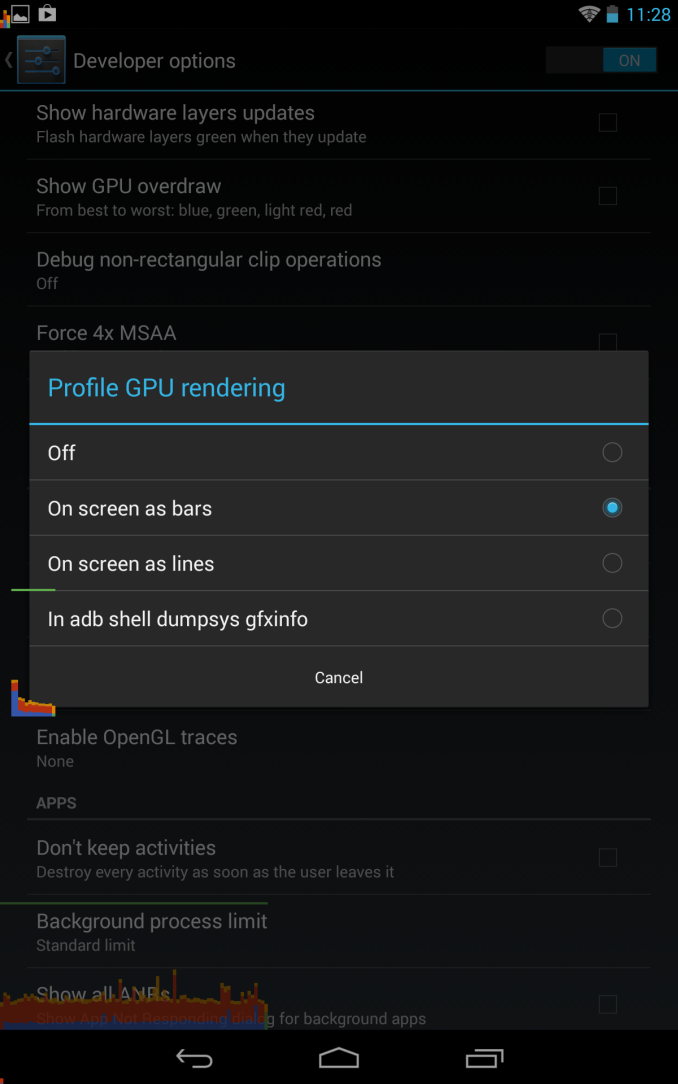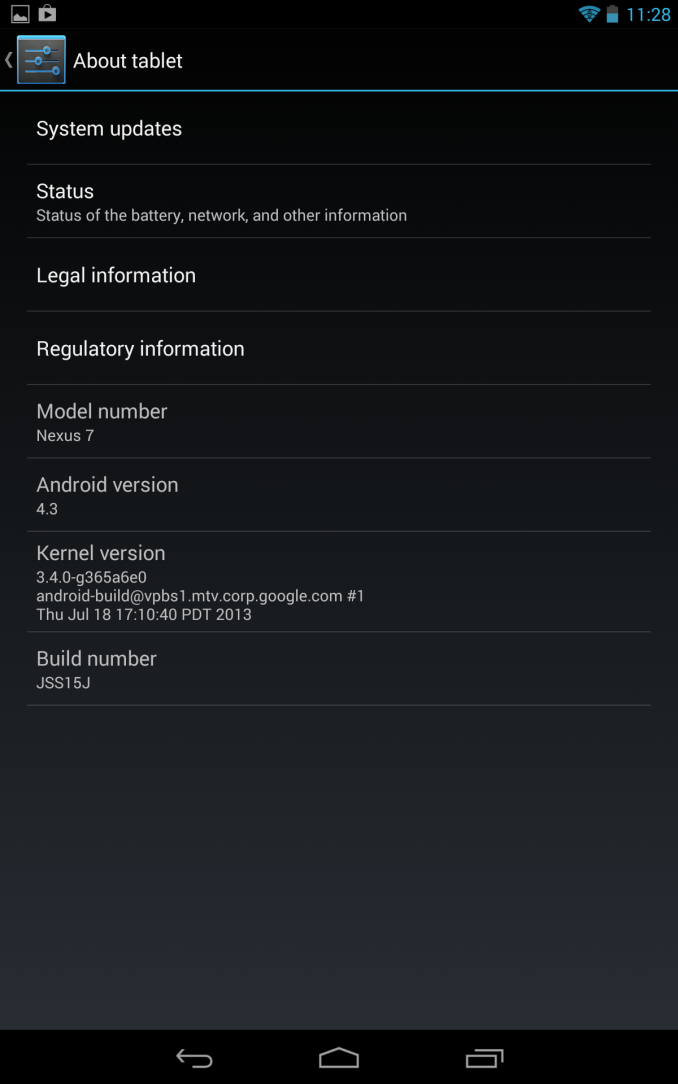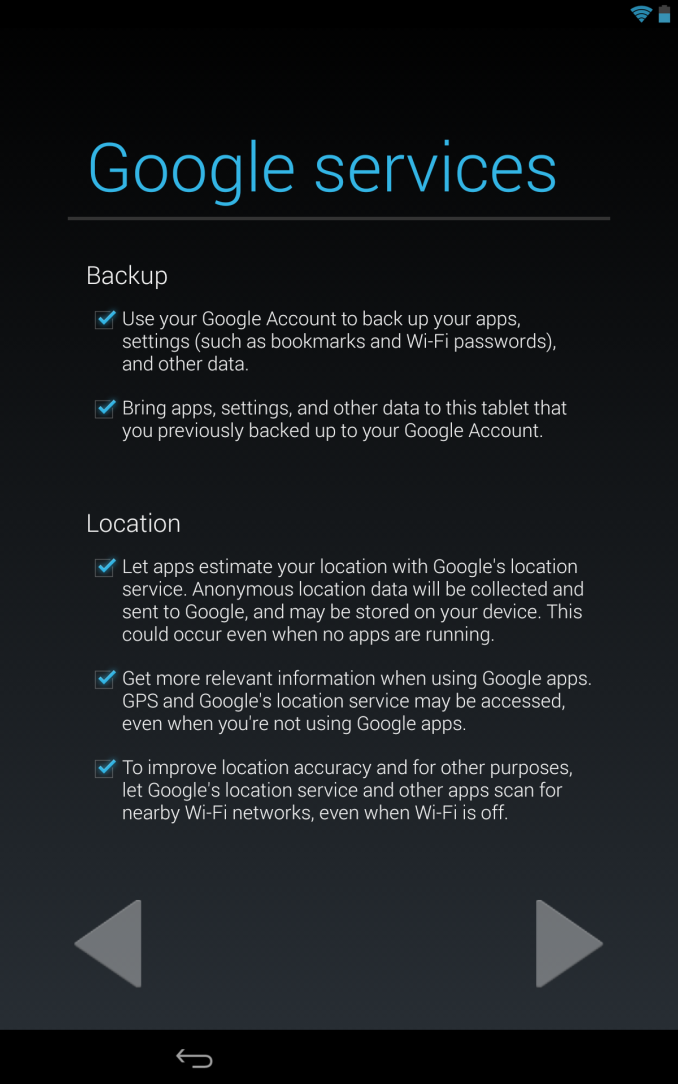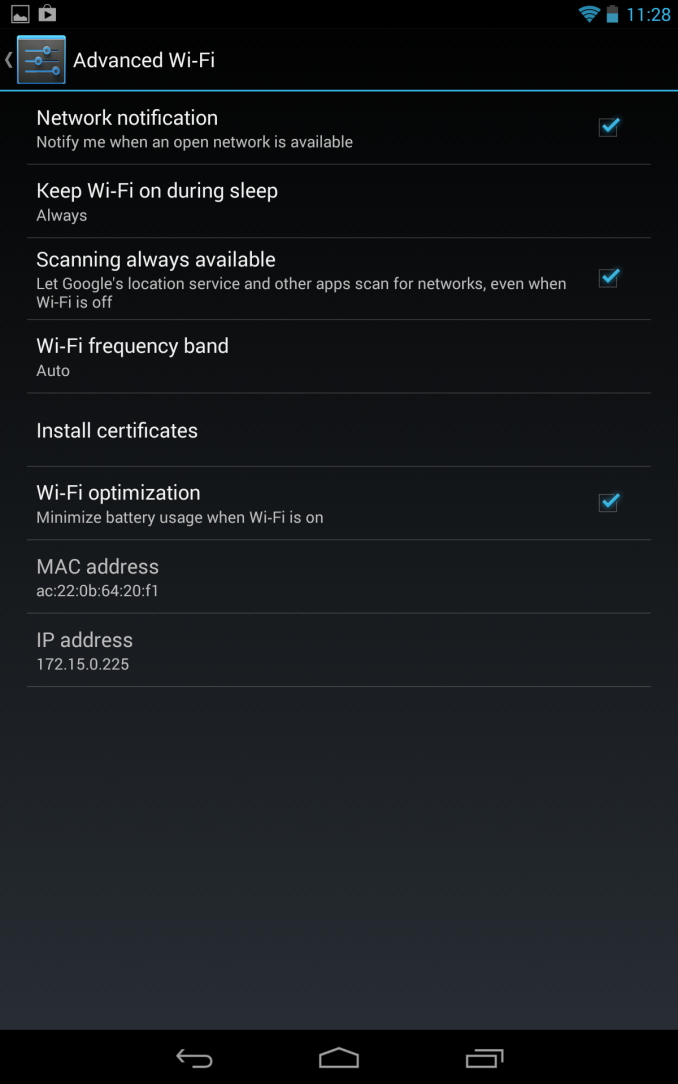What's New in Android 4.3
by Brian Klug on July 24, 2013 2:26 PM EST- Posted in
- Smartphones
- Android
- Mobile
- Tablets
- Android 4.3

As expected, today Google made a management release for Android 4.2 official at their breakfast with Sundar event, bumping the release up to Android 4.3 and introducing a bunch of new features and fixes. The update brings everything that Google alluded was coming during Google I/O, and a few more.
On the graphics side, the big change is inclusion of support for OpenGL ES 3.0 in Android 4.3. Put another way, Android 4.3 now includes the necessary API bindings both in the NDK and Java for ES 3.0. This release brings the numerous updates we’ve been over before, including multiple render targets, occlusion queries, instances, ETC2 as the standard texture compression, a GLSL ES 3.0, and more.
We’ve also talked about the changes to the 2D rendering pipeline which improve performance throughout Android, specifically intelligent reordering, and merging, which cuts down on the number of draw calls issued to the GPU for 2D scenes. This improvement automatically happens with Android 4.3 and doesn’t require developer intervention, the pipeline is more intelligent now and optimizes the order things are drawn and groups together similar elements into a single draw call instead of multiple. In addition like we talked about, non-rectangular clips have hardware acceleration, and there’s more multithreading in the 2D rendering pipeline.
Google has been trying to increase adoption of WebM and along those lines Android 4.3 now includes VP8 encoder support for Stagefright. The platform APIs are updated accordingly for the ability to change settings like bitrate, framerate, and so forth. New DRM modules are now added as well, for use with MPEG DASH through a new MediaDRM API.
On the connectivity side we get a few new features, first is the WiFi scan mode which we saw leaked in a bunch of different ROMs. This exposes itself as a new option under the Advanced menu under WiFi settings, and during initial out of box setup. This new scanning mode allows Google to continue to further build out its WiFi AP location database to improve WiFi-augmented location services for its devices.
Like we saw hinted not so subtly at Google I/O, 4.3 also includes support for Bluetooth low energy (rebranded Bluetooth smart) through the new Broadcom-sourced Bluetooth stack. This OS-level support for BT Smart APIs will do a lot to ease the API fragmentation third party OEMs have resorted to in its absence.
Likewise Bluetooth AVRCP 1.3 is now included which supports better metadata communication for car audio and other devices, as well as better remote control.
Security gets improvements as well, Android 4.3 moves to SELinux MAC (mandatory access control) in the linux kernel. The 4.3 release runs SELinux in permissive mode which logs policy violations but doesn’t break anything at present.
A number of other security features are changed, including fixes for vulnerabilities disclosed to partners, better application key protection, removal of setuid programs from /system, and the ability to restrict access to certain capabilities per-application. Lastly there’s a new user profiles feature that allows for finer grained control over app usage and content.
We'll be playing around with the new features on the new Nexus 7 as well as the other Nexus devices getting the update (Nexus 4, Nexus 10, Nexus 7 (2012), and Galaxy Nexus). Google has already posted the factory images for those devices as well if you're too impatient to wait for the OTA and want to flash it manually.
Source: Google


















69 Comments
View All Comments
marc1000 - Thursday, July 25, 2013 - link
Because of the user interface: the navigation app had big, clear and good colored buttons, plus a list of places where i actually GO to.By integrating it inside maps we are stuck with small icons, text almost unreadable during the day inside our car, and a few extra clicks required to start navigating. All these changes require the user to spend more time looking at the phone, instead of looking around his environment to prepare to drive.
In the use case of this kind of app, this kind of change in the user interface has a terrible impact.
NickDG - Sunday, July 28, 2013 - link
If you use Google Now! you just need to tell it where you want to go. No need to open any app. I just swipe up, hit the microphone icon and say the command.EnerJi - Wednesday, July 24, 2013 - link
Marc, I took a look at that link but couldn't reproduce your experience. I'm running Maps 7.02 and Android 4.2, and I still have a Navigation icon in my apps folder. Is there a newer version of Maps out?marc1000 - Thursday, July 25, 2013 - link
Enerji, most users are complaining that Maps 7.0x removed the icon to GPS Navigator app (that blue arrow icon), and we can ostart nav from inside maps now. Maybe you got lucky or your app is customized in sway.marc1000 - Thursday, July 25, 2013 - link
Some way*EnerJi - Thursday, July 25, 2013 - link
Interesting. I'm running a Nexus 4 with completely stock Android 4.2.2 (haven't received the 4.3 OTA yet). If the removal (or lack thereof) of Navigation is a bug/problem maybe it will be fixed with 4.3 (or more likely, the next version of Google Maps). Let's wait and see.marc1000 - Thursday, July 25, 2013 - link
Please tell us how it will end after you get the upgrade please. I will bookmark this post to see your answer in the future. Thanks.EnerJi - Tuesday, July 30, 2013 - link
I got upgraded to Android 4.3 over the weekend. After the upgrade, I immediately checked my applications drawer and Navigation was still there.*However*, at almost exactly the same time I was notified of a Google Maps application update. I allowed the app to update, and after the update I noticed that the Navigation is now gone. I checked the Google Maps version, and oddly enough it's *still* listed as 7.02 (the build number may have changed, but I didn't note it down previously.)
In summary, it appears you are right and Google is getting rid of direct access to Navigation for some reason. The upgrade to Android 4.3 may have simply been coincidental, and the device reboot that occurs with the upgrade may have simply triggered the Google Play store to download the latest application updates.
phoenix_rizzen - Thursday, July 25, 2013 - link
Running Maps 7.0.2 on Android 4.2.2 (Rootbox ROM) on an LG Optimus G.The "blue arrow" icon is still there.
Clicking it brings you to a screen with 4 icons across the top (car, bus, bike, walk) with two text fields below it (Choose starting point; Choose destination). Below that is a list of previous destinations, bookmarks, and more.
IOW, it takes fewer clicks now, and still works the same way as before.
Spoelie - Thursday, July 25, 2013 - link
What I noticed after using Google navigation for the past years, and now using the built-in GPS in my car (Audi), is that Google still has some serious polishing to do.Their minimal interface just makes it unclear what options are hidden where and for the IOS app initially I couldn't find how to even start route guidance. As for the basics I regularly missed highway ramps due to unclear instructions and frustratingly high auto-zoom, without any control over it.
You would never know it could be so much better if all you use is Google's app.